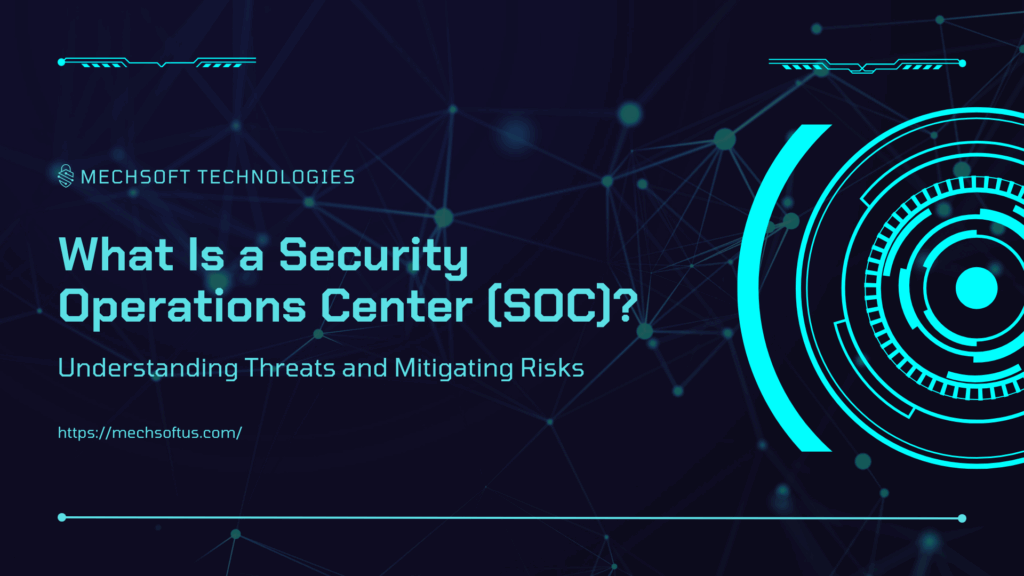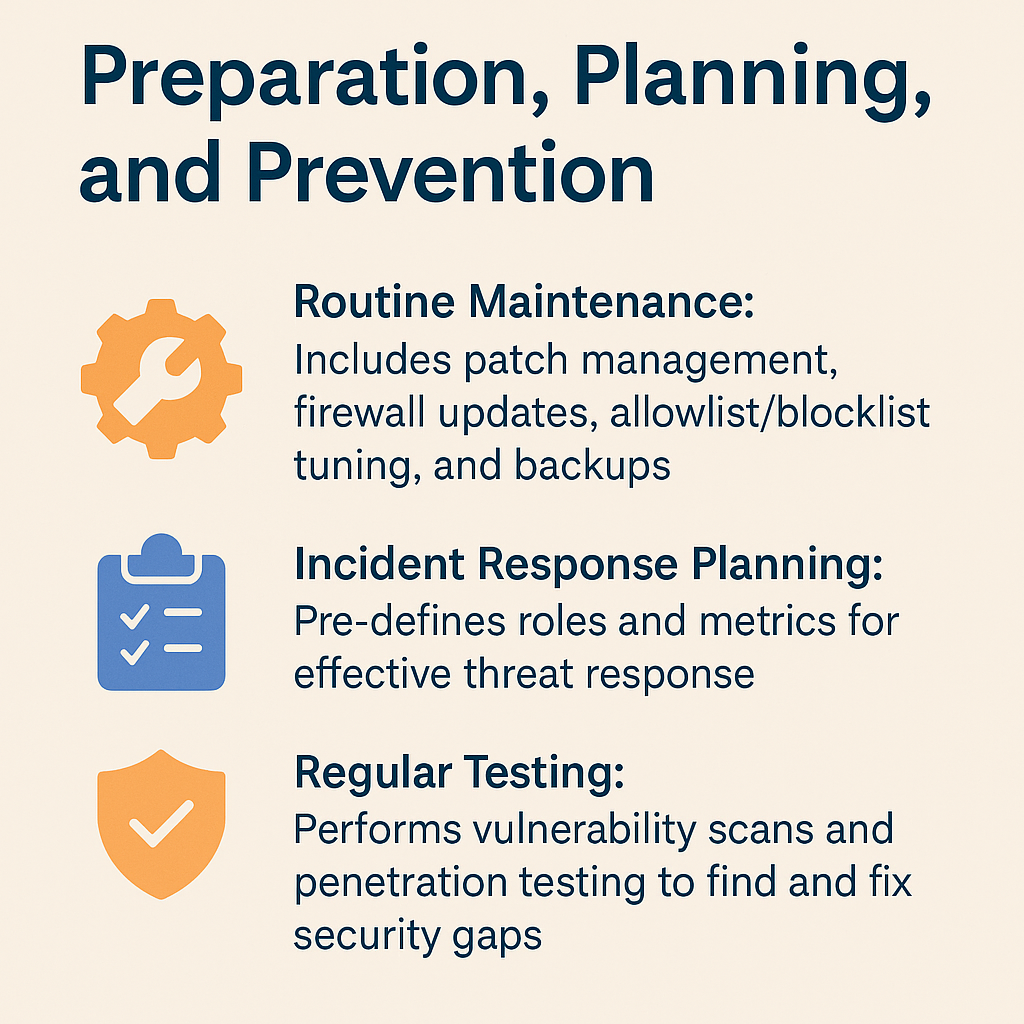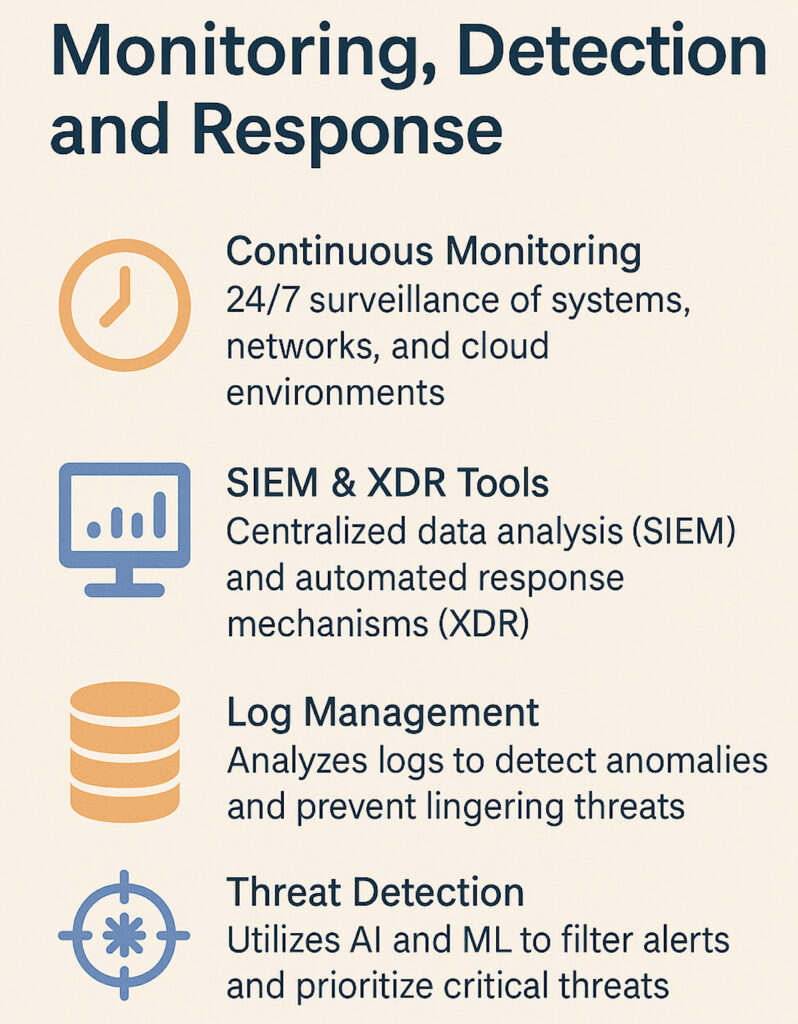What Is a Security Operations Center (SOC)?

A Security Operations Center (SOC) is a dedicated team, either in-house or outsourced, of cybersecurity professionals who constantly monitor an organization’s IT infrastructure. The primary goal of a SOC is to detect, analyze, and respond promptly to security incidents, ensuring continuous protection against evolving cyber threats.
By integrating security tools, policies, and response protocols, a SOC strengthens the organization’s defense, leading to quicker threat detection, improved security policies, and more effective incident responses. Organizations benefit significantly from enhanced customer trust and streamlined compliance with privacy regulations such as GDPR, HIPAA, PCI DSS, and CCPA.
Key Responsibilities of a Security Operations Center (SOC)
Preparation, Planning, and Prevention

- Routine Maintenance: SOC teams regularly update and patch software, manage firewalls, update allowlists and blocklists, and maintain backup systems to ensure robust, ongoing protection.
- Incident Response Planning: SOC teams develop clear, comprehensive plans detailing roles and responsibilities during security incidents, including specific metrics to evaluate response effectiveness.
- Regular Testing: Vulnerability assessments and penetration tests are routinely conducted to identify and address system weaknesses proactively. Insights from these tests guide improvements in security practices.
Monitoring, Detection, and Response

- Continuous Monitoring: SOCs monitor IT systems around-the-clock, scrutinizing applications, servers, networks, and cloud environments for suspicious activities or known threats.
- SIEM and XDR Technologies: Core monitoring technologies include Security Information and Event Management (SIEM), which aggregates and analyzes security data. Many SOCs now also utilize Extended Detection and Response (XDR) for deeper insights and automated incident response.
- Log Management: Effective log management involves detailed analysis of data logs to identify anomalies indicating potential threats, helping prevent attackers from lingering undetected within systems.
- Threat Detection: Advanced systems, often leveraging AI and machine learning, help SOC teams swiftly identify genuine threats amidst numerous alerts, prioritizing incidents based on severity.
Recovery, Refinement, and Compliance

- Incident Recovery: Following a security breach, SOC teams remove threats, restore affected systems, and ensure operations swiftly return to normal, often involving backup systems and credential resets.
- Post-Incident Analysis: Teams analyze incidents to refine security strategies, update policies, and strengthen defenses against future threats, continually adapting to emerging cybersecurity trends.
- Compliance Management: SOCs ensure compliance with various security and privacy regulations, managing notifications and maintaining records required by law following incidents.
Benefits of a Security Operations Center (SOC)
- Asset Protection: Proactive security measures minimize breaches, protecting valuable organizational assets and sensitive information.
- Business Continuity: SOCs reduce the frequency and severity of cyber incidents, maintaining operational stability and minimizing disruption.
- Regulatory Compliance: SOCs help ensure organizational adherence to regulatory frameworks, facilitating smooth audits and regulatory interactions.
- Cost Efficiency: Investing in SOC services significantly reduces the risk of costly data breaches, outweighing initial investments by mitigating potential damages and operational disruptions.
- Customer Trust: A robust cybersecurity posture demonstrated by an active SOC helps build trust with customers and stakeholders.
- Enhanced Incident Response: SOC teams quickly address threats, reducing downtime and financial impacts.
- Improved Risk Management: Continuous threat analysis enables SOCs to proactively address vulnerabilities before exploitation.
- Proactive Threat Detection: Constant monitoring ensures rapid detection and management of threats, safeguarding against potential cyberattacks.
Typical SOC Team Roles
- SOC Manager: Oversees the team, manages operations, and coordinates with organizational cybersecurity leadership.
- Security Engineers: Develop and maintain security systems, tools, and architecture, collaborating closely with development teams.
- Security Analysts: Frontline responders who detect, investigate, and prioritize threats, initiating immediate containment and mitigation actions.
- Threat Hunters: Specialized analysts who proactively seek and address sophisticated cyber threats, continually enhancing defense strategies.
Why Mechsoft Technologies Security Operations Center in sacremento in California ?
Mechsoft Technologies stands out as a premier provider of Security Operations Center (SOC) services in Sacramento, California, offering comprehensive, 24/7 cybersecurity solutions tailored to businesses of all sizes. Their SOC-as-a-Service (SOCaaS) delivers real-time threat detection, incident response, and continuous monitoring, ensuring robust protection against evolving cyber threats. With a team of certified experts and a commitment to ISO 27001 standards,
Mechsoft integrates advanced technologies like SIEM and XDR to provide proactive defense mechanisms. Their holistic approach not only safeguards digital assets but also aligns with compliance requirements, making them a trusted partner in fortifying your organization’s security posture.
